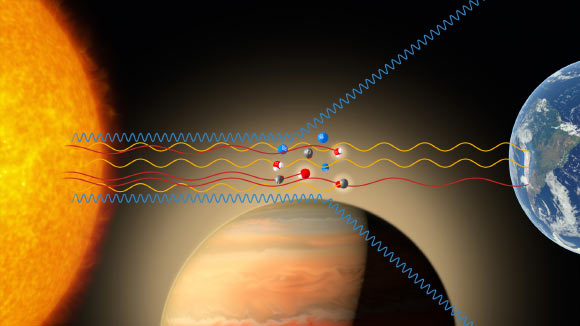Astronomers using ESO’s Very Large Telescope (VLT) have detected titanium oxide in the atmosphere of the hot-Jupiter exoplanet WASP-19b.

An artist’s impression showing WASP-19b, in which atmosphere astronomers detected titanium oxide for the first time. WASP-19b’s atmosphere is estimated to have a temperature of about 2,000 degrees Celsius. Image credit: M. Kornmesser / ESO.
WASP-19b was discovered in 2009 by a large group of astronomers led by University of St. Andrews astronomer Leslie Hebb.
The planet has a mass of 1.15 times that of Jupiter, a radius of 1.31 times that of Jupiter, and an orbital period of just 19 hours.
It orbits WASP-19 (also known as GSC 08181-01711 and 2MASS J09534008-4539330), a magnitude 12.3 star located in the southern constellation of Vela, approximately 815 light-years from Earth.
As WASP-19b passes in front of the star, some of the starlight passes through the planet’s atmosphere and leaves subtle fingerprints in the light that eventually reaches Earth.
By using VLT’s FORS2 instrument, ESO astronomer Elyar Sedaghati and co-authors were able to carefully analyze this light and deduce that the atmosphere contained small amounts of titanium oxide (TiO), water and traces of sodium, alongside a strongly scattering global haze.

As WASP-19b passes in front of its parent star, some of the starlight passes through the planet’s atmosphere and leaves subtle fingerprints in the light that eventually reaches Earth. By using the FORS2 instrument on ESO’s Very Large Telescope, Sedaghati et al were able to carefully analyze this light and deduce that the atmosphere contained titanium oxide. In large enough quantities, titanium oxide can prevent heat from entering or escaping an atmosphere, leading to a thermal inversion — the temperature is higher in the upper atmosphere and lower further down, the opposite of the normal situation. Image credit: M. Kornmesser / ESO.
“Detecting such molecules is, however, no simple feat. Not only do we need data of exceptional quality, but we also need to perform a sophisticated analysis,” Dr. Sedaghati said.
“We used an algorithm that explores many millions of spectra spanning a wide range of chemical compositions, temperatures, and cloud or haze properties in order to draw our conclusions.”
“Titanium oxide is rarely seen on Earth. It is known to exist in the atmospheres of cool stars. In the atmospheres of hot planets like WASP-19b, it acts as a heat absorber.”
“If present in large enough quantities, these molecules prevent heat from entering or escaping through the atmosphere, leading to a thermal inversion — the temperature is higher in the upper atmosphere and lower further down, the opposite of the normal situation.”
“Ozone plays a similar role in Earth’s atmosphere, where it causes inversion in the stratosphere.”
“The presence of titanium oxide in the atmosphere of WASP-19b can have substantial effects on the atmospheric temperature structure and circulation,” noted co-author Dr. Ryan MacDonald, an astronomer at Cambridge University, UK.
“To be able to examine exoplanets at this level of detail is promising and very exciting,” added Cambridge University astronomer Dr. Nikku Madhusudhan, who oversaw the theoretical interpretation of the observations.
The research is published in the journal Nature.
_____
Elyar Sedaghati et al. 2017. Detection of titanium oxide in the atmosphere of a hot Jupiter. Nature 549: 238-241; doi: 10.1038/nature23651







